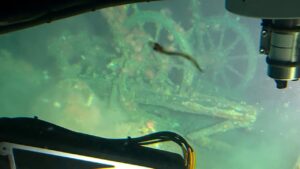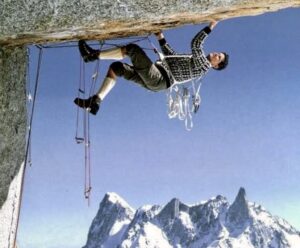Seven Russian teenagers skied [the last degree of latitude] to the North Pole last week. The 2016 climatic and political cyclone that had shattered plans of most heading to the North Pole via Barneo forced the party guided by Matvey Shparo to complete the whole trip in just 5 days instead of 7-10 originally planned.
At first, they were stranded in Moscow for over a week waiting for a green light from Barneo where one runway was breaking after another one. “There were no plans to stay in Moscow for more than one night, so we moved to one of the city’s schools gym where we installed our tents and went to classes during the day, ready to take off a.s.a.p if the opportunity arrived,” – said Anya Kalmuchina, 16, a student of Khabarovsk Polytechnic college in the Russia’s Far East.
Seven kids representing seven different regions, from Siberia in the East to Saint Petersburg in the West, came out winners in the 9th national competition for a spot in the “North Pole Skiing Team 2016”. The selection which included participation in ski races, the Intellectual Arctic Olympiad – a national contest for the best knowledge of the Arctic’s history, the North Pole essay competition, was finalized during the most challenging quest at Shparo’s family “The Great Adventure” youth camp in Karelia, on the border with Finland.
Here they learned survival skills, skiing in the waist-deep snow and crossing open water in dry suits, while an experienced team of explorers, doctors and psychologists was monitoring the process from the beginning to the end. “What was the selection criteria this year?” I asked Dmitry Shparo, a founder of the Adventure Club which along with the Russian Ministry of Education and Science, Association of Polar Explorers and Russian Expedition Center of the Russian Geographical Society runs this annual expedition. In the previous years the team included children with disabilities, both mental and physical, orphans, and neglected children from underprivileged families – among others.
“For sure, are not choosing “stars”. Children that are going to the Pole this year are normal kids. But their passion, their incredible desire to reach the North Pole is such that they can overcome many more obstacles than other kids. A child in our team does not have to be the smartest, the strongest, or the most decorated. We know their individual weaknesses, but when we finalize the team it works like a perfect engine”.
Last year Arina Rychkova, then 16, a law student at the city college of Kirov in southern Russia, failed the final test in Karelia and was sent home. For her it was a personal disaster. But the failure did not prevent her from applying again – next year – and doing everything from scratch. And this time she won.
“I dreamed of going to the North Pole since I was 5 years old, said Arina. – It is the most beautiful place on Earth and if I did not get a spot this year, I would have just kept applying”.
These kids, who by the early age of 16 or 17 have done a lot of good things for the others such as rescuing people from fires and floods, are stubborn. And their sense of humor is just extraordinary. They kept laughing all the way to Barneo when it finally gave them the green light.
From Barneo they were taken by a helicopter to the starting point at “the last degree”. We left them on the ice and they headed North immediately: the time was running out. In the previous years the Children’s Ski Expedition would normally start no later than April 9th, which gave enough time to deal with drifts, winds and other unpredictabilities of the weather. This year they had to rush to the Pole with a mere hope for the mercy of the elements.
We said good-bye and took off to Barneo via the North Pole. Flying at low altitude we could see many things otherwise invisible. The closer we were approaching the North Pole the more leads and hummocks emerged. It was clear that the final approach to the Pole would be climbing and swimming rather than skiing.
Later in that night we made another helicopter trip to the North Pole flying over a different route. The landscape was just the same. Interestingly enough, we did not see a single seal, even though it’s a high season now, and therefore – not a single polar bear
We were able to reach Matvey Shparo by satellite phone the same night and he described their route as a “Zigzag Journey”. He said: “It’s a lot of extra work, but it’s not bad for the kids. It is sort of magical to see how from “separate beings” they are smoothly turning into a “one living organism.”
Next day they made about 25 km and aso learned that the new cyclone was approaching the Pole. It meant they had to accelerate their speed. The temperature fell to -25C and the gusty wind was raising its fury.
Two more days and nights of “zigzag skiing”, and then finally they approached the area of the open water. It was a perfect chance to try their dry suits. And they did. Five minutes before midnight, on the fifth day of the journey, they reached the Pole.
Emotions overwhelmed them, and they were lucky enough not to know that the flight Moscow – Longyearbyen – Barneo scheduled to bring them back home was not in the air. Just minutes before the departure the permission previously granted by the Norwegian authorities for this charter flight has been abruptly revoked. The children’s battle for the Pole was over, but another battle – of adults on the ground – was just increasing its magnitude. The parachuting of the Chechen “Air Squad” onto the North Pole has brought life on Barneo into one big turmoil, causing tensions and tightening of transportation rules which resulted in multiple delays and even cancellations.
Luckily, just a few hours later the permission was granted again. By the end of the day the children were successfully picked up on the Pole and brought back to Barneo.
They did not look tired or exhausted; instead they kept laughing. They said they could easily ski for 300 or 400 km more. They regretted that the journey was too short, but they were happy with what they have accomplished. The only disappointment was that they did not see polar bears as they have so much hoped: not a single one.
On the way to Barneo their backpacks were heavier than they were at the start: from the North Pole the kids brought kilograms of ice: they wanted to share it with their classmates.
“Of course, our expedition was not like “another walk in the park”, – said Elmira Musina, 17, a student from the city of Chelyabinsk in the Ural Mountains. – But it was much easier than the training in Karelia. We were ready. The most difficult part in the journey was multitasking: you have to deal with many things at once, and then you have to also help your partners.”
When I asked a “silly” question “Why did you want to go to the North Pole to begin with?” the kids said that their main aspiration was to inspire their friends and classmates who spend too much time on the couch in front of television or in computer gaming to be more active and to learn to make dreams and to reach them despite all odds”.
PS: In conclusion, I would like to thank very much Irina and Alexaner Orlov, the founders and operators of Barneo Ice Camp, for all of their support, hospitality and help for the author in being able to write this article.
[Editor’s note, May 16, 2016. Please note that the teenagers skied the Last Degree of Latitude to the North Pole, which is 110 km and usually done in 6-10 days. It could be confusing, stating they have “skied to the North Pole”. Adventurers who had “skied to the North Pole” had done a full route from land to the Pole, which takes two months to complete.]






